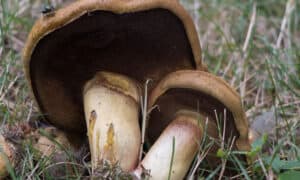While the mushrooms typically depicted in movies, games, and fantasy novels tend to look nothing like wood, there are actually a whole host of species with wood-like appearances. These mushrooms overwhelmingly grow on trees and live for many years.
In this guide, we’ll describe five species of mushrooms that look like wood. We’ll cover where they grow, and what, if any uses, humans have for them. Before we jump in to list the five species, we’ll talk a bit about the category of fungi that wood-like mushrooms typically belong to. Read on to find out more.
Polypore Bracket Fungi
If you come across mushrooms that look like wood, you’ve almost certainly found a polypore bracket fungus. These mushrooms grow on living and/or dead trees, stumps, and logs and contain pores underneath the cap, rather than gills. Pores are hollow, tube-like structures covered in spore-producing cells. On many mushrooms with wood-like appearances, the pores are so small the underside of the mushroom may seem completely smooth.
Sometimes, these mushrooms are also called shelf fungi. This is in reference to how they grow as shelf-like formations on their tree hosts. With this shelf-like growth habit, the underside of the mushroom is well-exposed to being able to release its spores onto the wind currents.
They can grow at the base of a tree or further up the trunk. Often, these mushrooms are either parasitic, saprobic, or a combination of both at different stages of their life cycle. Parasitic fungi obtain nutrients by infecting a live, usually tree, host. Saprobic fungi, in comparison, obtain their nutrients by breaking down dead organic matter. Often, many parasitic bracket fungi can exhibit both behaviors.
While the fruiting body of some species of polypore bracket fungi only live a couple of weeks or months, some can live for several years, and even decades. The bracket mushrooms that can live for many years are often quite woody in appearance with a tough texture. Typically, the mycelium of the fungus is active within the tree for years before it develops enough energy to produce the tough, woody mushroom.
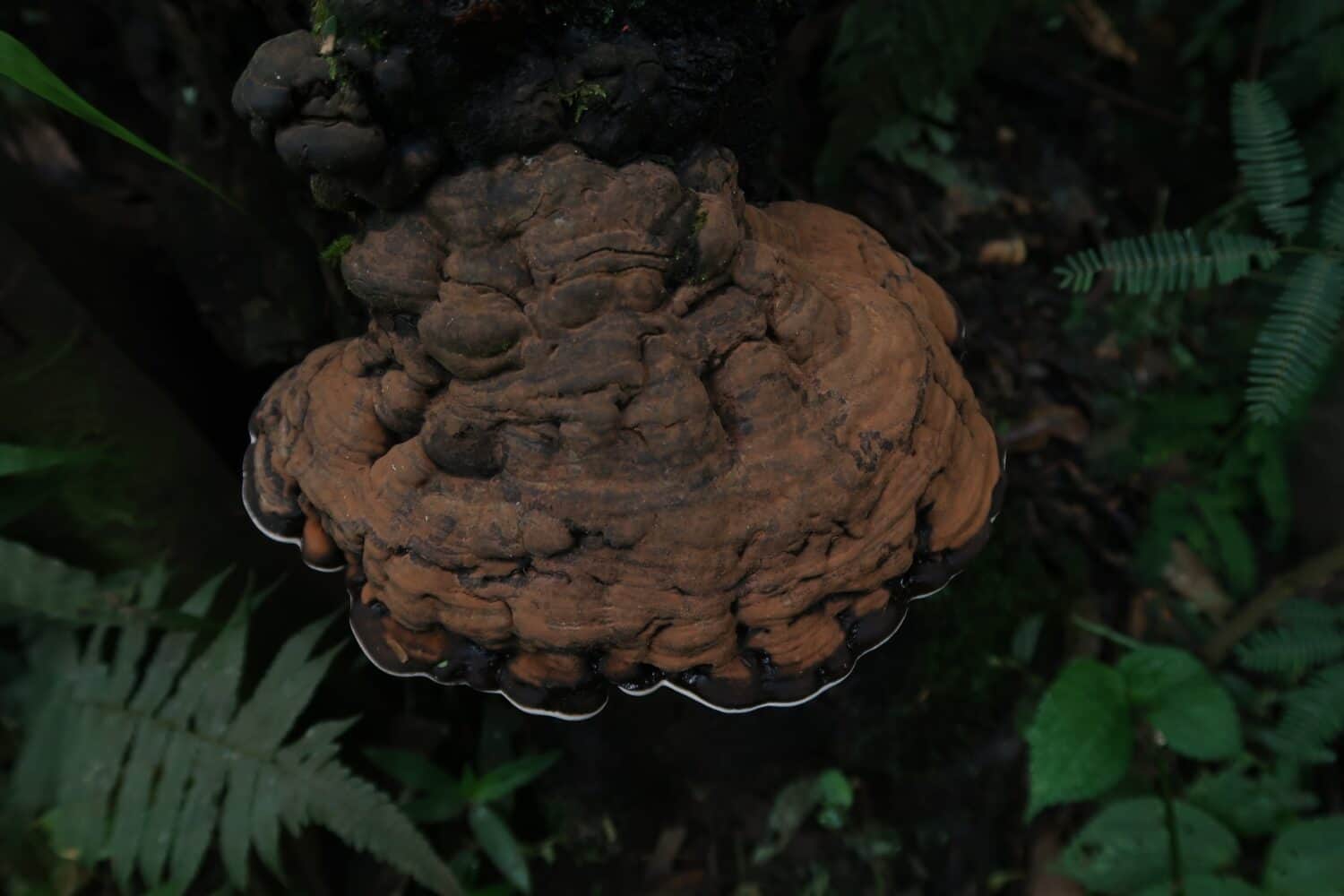
Some bracket and shelf mushrooms can look a whole lot like wood.
©Neng etta/Shutterstock.com
1. Chaga Mushroom (Inonotus obliquus)
A quick glance at chaga growing in its native environment might fool you into thinking you’re looking at a woody tumor on a tree. Chaga (Inonotus obliquus) has a distinctly charred-wood appearance on the heartwood of trees that it parasitizes. This mushroom prefers to grow on live birches. However, you can also find it fruiting on oaks, poplars, alders, ashes, and maples.
Not only does this mushroom look like wood, but it’s also about as tough. Those breaking apart chunks of chaga often use hammers or a small hatchet and chisel. When broken apart, the inside of the mushroom reveals a stunning burnt-orange flesh.
This wood-like mushroom is native to cool-cold forested regions of the northern hemisphere across parts of northern Europe and Asia, Russia, Canada, Alaska, and the northernmost regions of the US. The fruiting body of this unique fungus can grow for many years, and foragers can harvest the mushroom year-round. Typically, this extremely slow-growing mushroom is at least 15 years old before it reaches a harvestable size.
People harvest chaga for its purported medicinal properties, some of which seem to be supported by preliminary research.
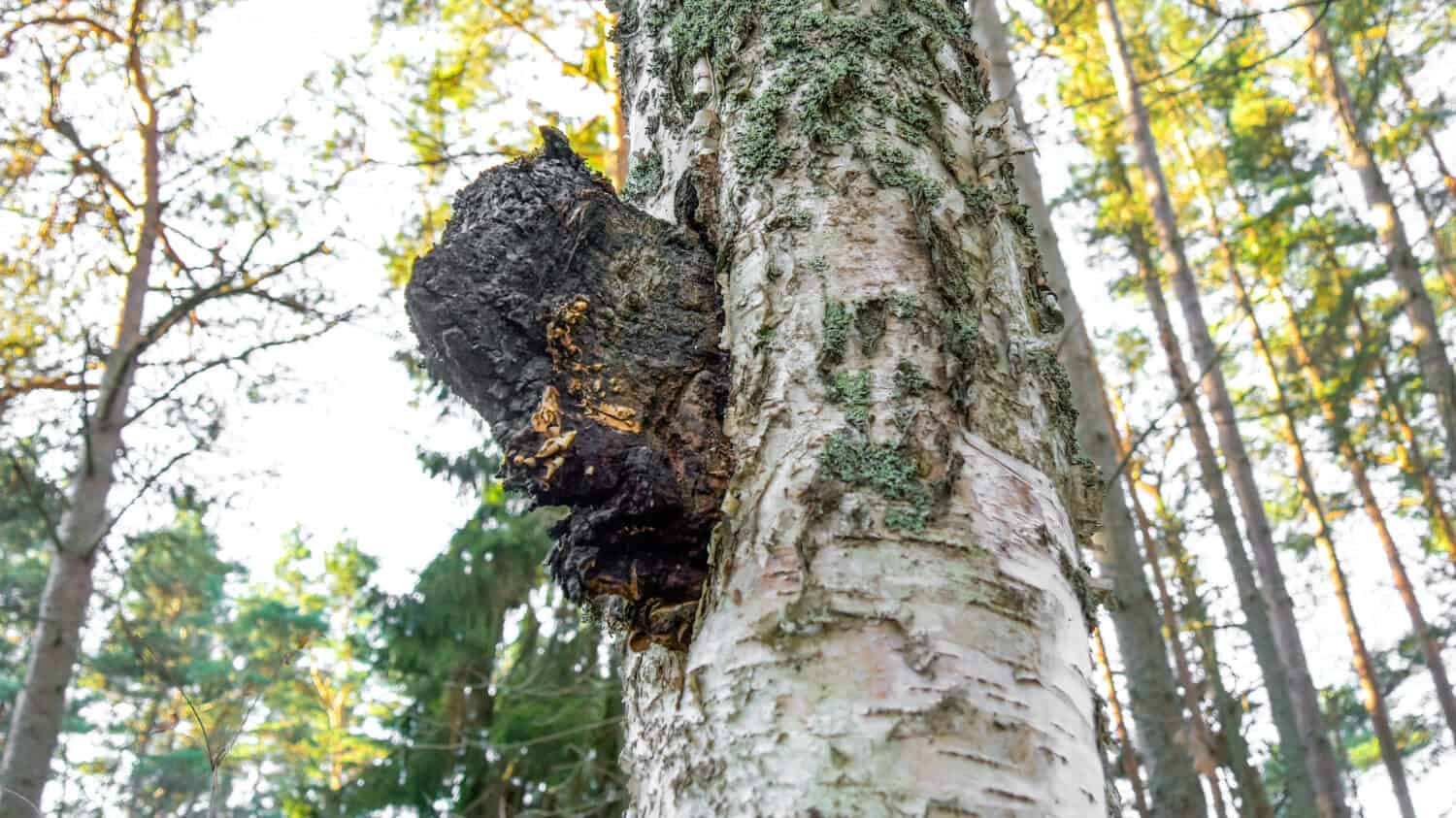
You will find many things misidentified as chaga online, but this is the real deal.
©Nordic Moonlight/Shutterstock.com
2. Reishi Mushroom (Ganoderma lucidum)
Another mushroom with a woody appearance long prized for its potential medicinal uses is the reishi mushroom (Ganoderma lucidum). This mushroom is endemic to temperate regions of East Asia and is also cultivated worldwide for use in teas, tinctures, and supplemental powders. Modern research does confirm that some bioactive compounds in reishi may have various health-benefiting effects such as anti-inflammatory, antioxidant, and anti-tumor.
When young, the reishi mushroom has a glossy exterior and woody texture, giving the fungus the appearance of being freshly wood-stained. As it ages, it loses this gloss and fades more into the overall look of the tree trunk base or stump from which it grows.
This kidney-shaped mushroom has a parasitic or saprobic relationship with several tree species. As a parasitic fungus, reishi causes a white rot in the woody tissue and main stem of the tree, often causing slowed growth. In its saprobic phase, Ganoderma lucidum breaks down the lignin, cellulose, and hemicellulose in the tree, contributing to crucial nutrient recycling in the process.
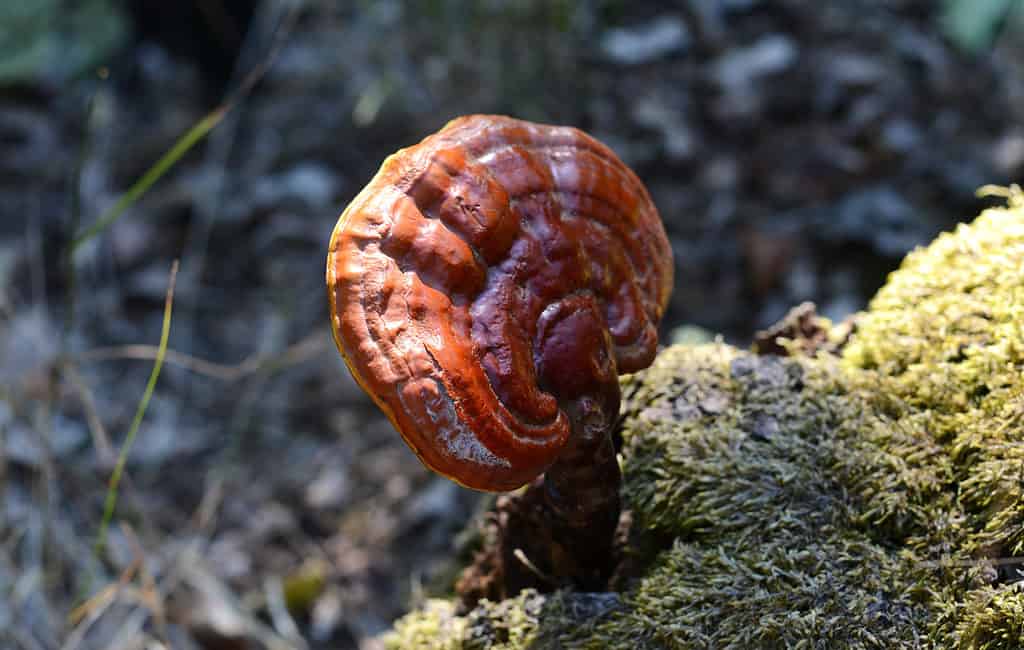
A beautiful reishi mushroom with a distinct stem
©milart/Shutterstock.com
3. Mushrooms that Look Like Wood: Artist’s Bracket Fungus (Ganoderma applanatum)
For artists, the next mushroom on our list is an absolute delight. The artist’s bracket fungus (Ganoderma applanatum) receives its common name from the practice of artists using the underside of the mushroom as a natural canvas. This woody bracket fungus is incredibly tough, allowing people to display their art for many years. Carving and then burning the design into the tough underside is a popular method.
This polypore fungus is endemic to temperate, forested regions of North America, Europe, and Asia. It features a semicircle-shaped fruiting body and a dull, unvarnished gray-brown cap. The underside is off-white to pale tan, making it an excellent color for use as a canvas.
Like reishi, Ganoderma applanatum is both parasitic and saprobic on living and dead trees. In addition to its use by artists, some also harvest this mushroom for purported medicinal benefits. Historically, this mushroom is particularly popular in Chinese medicine for the treatment of a range of ailments including indigestion, joint pain, and respiratory illnesses. Some studies do report that this mushroom contains many bioactive compounds that display potential for antibacterial, antiviral, antitumor, antidiabetic, and antifibrotic uses.
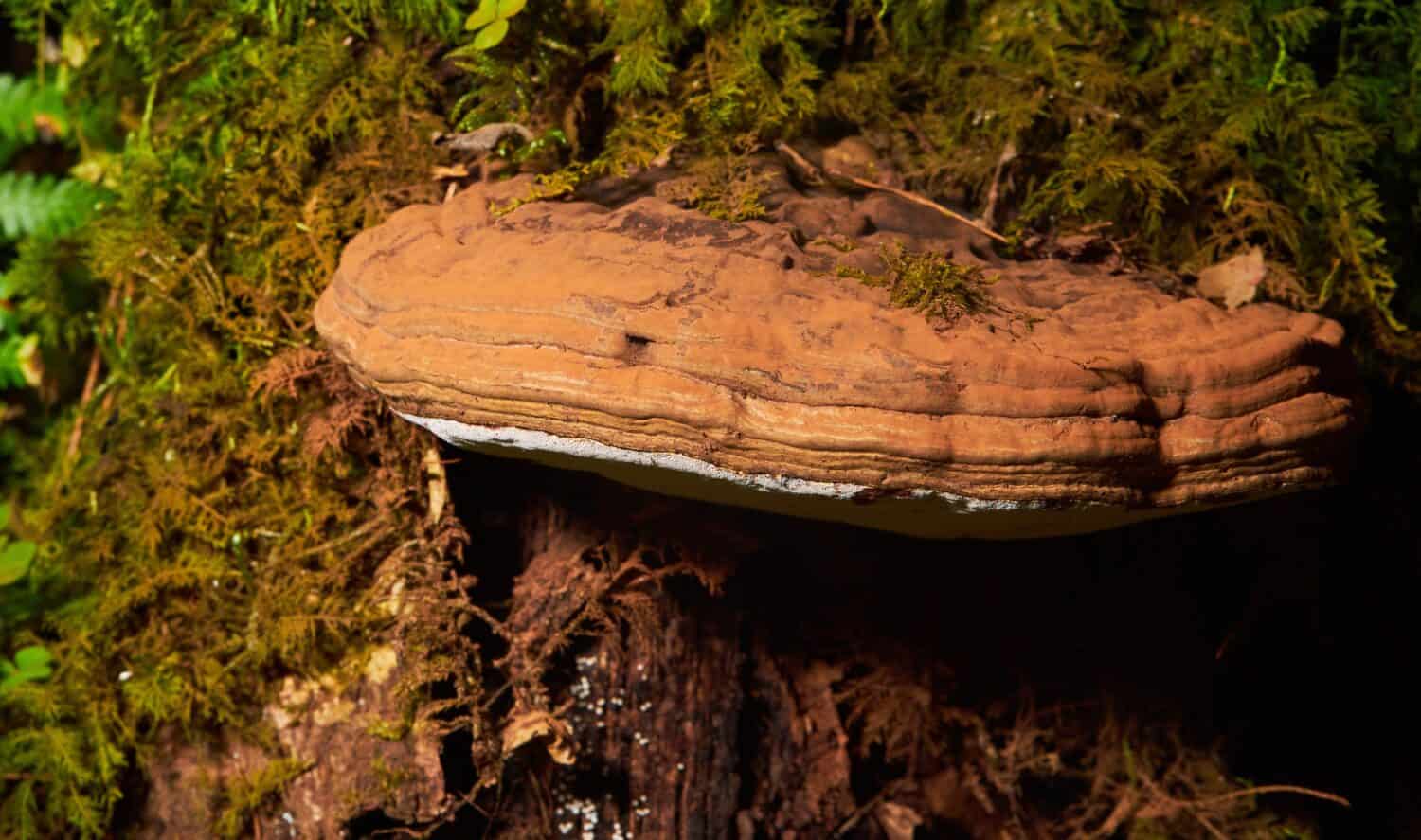
can look a lot like wood and can make some amazing art pieces.
©krolya25/Shutterstock.com
4. Tinder Fungus (Fomes fomentarius)
The tinder fungus (Fomes fomentarius), also known as the hoof fungus, is a tough, woody polypore mushroom that fruits from standing and fallen hardwoods. Like the chaga mushroom, you could quite easily mistake, especially older specimens, for a woody growth on a tree, rather than a mushroom.
This dense, hoof-shaped mushroom features a gray to grayish-brown cp that is often cracked. The cracking adds to the wood-like appearance of this interesting mushroom. The inside of the mushroom is quite tough and typically requires tools to break apart.
The tinder fungus has a far-reaching native range. Its distribution extends across northern and southern areas of Africa, Asia, eastern North America, and Europe. One interesting aspect of this mushroom, and the reason for its common name, is that people use it for fire tinder. In fact, the famous Tyrolean Iceman was found with Fomes fomentarius in his girdle bag, which researchers posit he was carrying for use in starting fires.

This mushroom has a rich history along side the evolution of mankind.
©Real PIX/Shutterstock.com
5. Mushrooms that Look Like Wood: Willow Bracket Fungus (Phellinus igniarius)
The willow bracket fungus (Phellinus igniarius), also known as the fire sponge, is a perennial polypore fungus. It grows from the bark of live or dead willow and other broad-leafed trees. When it infects the tree, this parasitic fungus causes a white wood rot. Phellinus igniarius grows natively in temperate forested regions across much of North America, Asia, and Europe.
This bell or hoof-shaped fungus is quite tough and woody in appearance and texture. It is capable of growing for many years on its host tree. The cap of this polypore fungus is often cracked like bark. Also, mature species can be found with lichen and moss growing on them, adding to their wood-like appearance.
Phellinus igniarius is one of the most commonly used mushrooms in traditional Asian medicines. It is also well-studied with the first group of modern research dating back to the 1960s. Extensive research across Asia, the U.S., and Europe confirms the presence of many potentially health-benefitting bioactive compounds. These compounds are shown to display a range of effects. These effects include anti-tumor, anti-allergic, cytostatic, immunomodulatory, antibacterial, anti-fungal, hypoglycemic, and hepatoprotective actions.
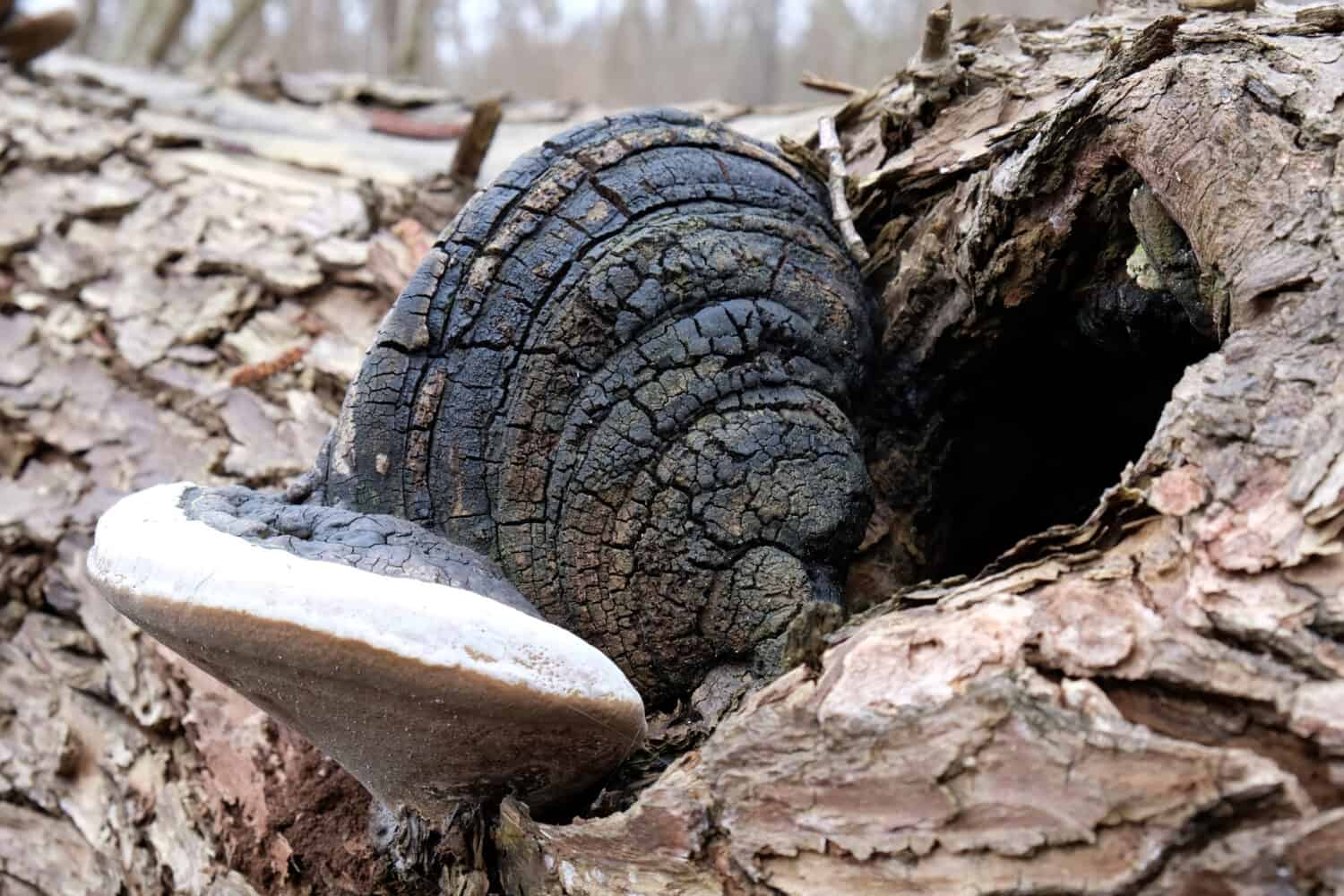
and
Fulvifomesspp. can really resemble wood!
©iwciagr/Shutterstock.com
| Mushrooms that Look Like Wood | Name |
|---|---|
| #1 | Chaga Mushroom (Inonotus obliquus) |
| #2 | Reishi Mushroom (Ganoderma lucidum) |
| #3 | Artist’s Bracket Fungus (Ganoderma applanatum) |
| #4 | Tinder Fungus (Fomes fomentarius) |
| #5 | Willow Bracket Fungus (Phellinus igniarius) |
The photo featured at the top of this post is © Nick Greaves/Shutterstock.com
The information presented on or through the Website is made available solely for general informational purposes. We do not warrant the accuracy, completeness, or usefulness of this information. Any reliance you place on such information is strictly at your own risk. We disclaim all liability and responsibility arising from any reliance placed on such materials by you or any other visitor to the Website, or by anyone who may be informed of any of its contents. None of the statements or claims on the Website should be taken as medical advice, health advice, or as confirmation that a plant, fungus, or other item is safe for consumption or will provide any health benefits. Anyone considering the health benefits of particular plant, fungus, or other item should first consult with a doctor or other medical professional. The statements made within this Website have not been evaluated by the Food and Drug Administration. These statements are not intended to diagnose, treat, cure or prevent any disease.
Thank you for reading! Have some feedback for us? Contact the AZ Animals editorial team.



